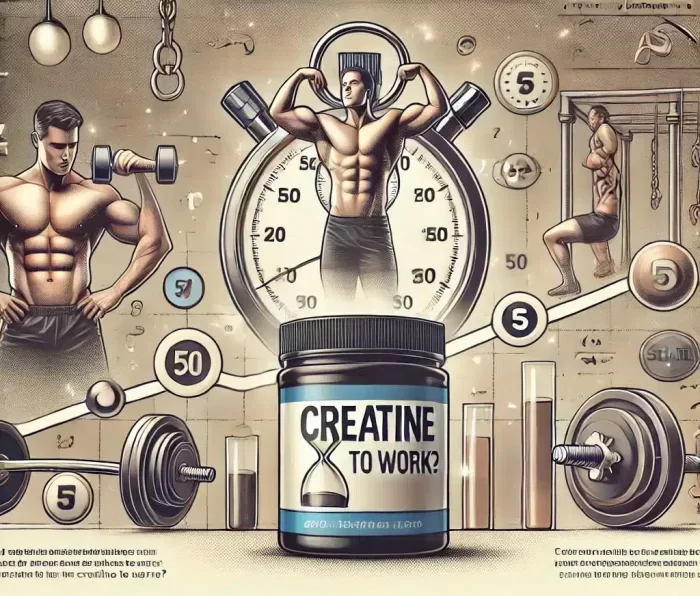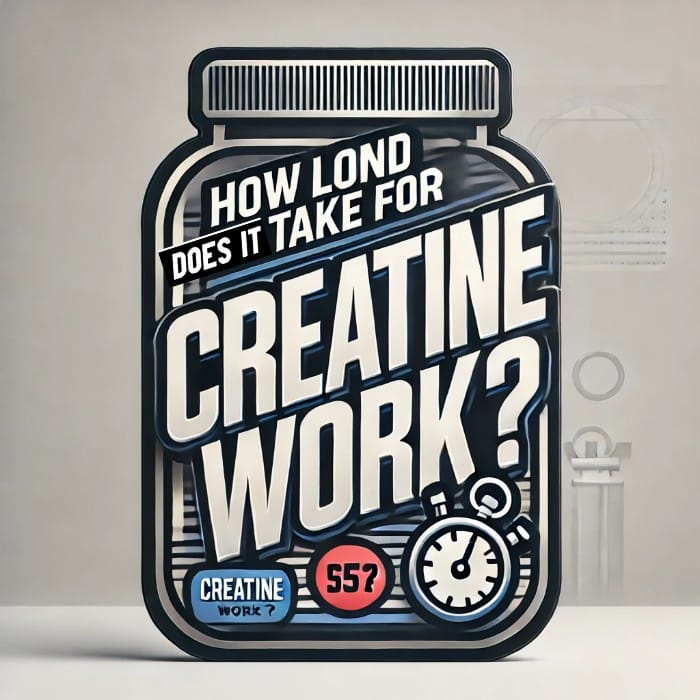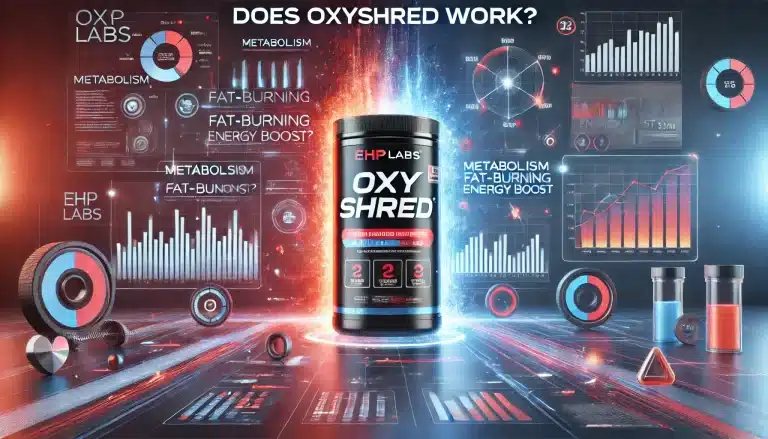How Long Does It Take For Creatine To Work?
Everybody knows that if you want to get big and jacked, as well as training hard you need to ensure that you’re eating right as well. Muscles, as they say, are made in the kitchen, not the gym. While that saying is not entirely accurate, it does give you a rough indication of just how important diet and nutrition are when it comes to lean muscle growth.
As well as eating right, to maximize our gains we should also ensure that we’re using the right supplements, in the right dosages, for the correct duration of time. Whereas whey protein might be the most popular fitness supplement out there, the second-most popular has to be creatine. Creatine supplements are popular amongst bodybuilders, strength athletes, and fitness enthusiasts. This basic supplement provides a cavalcade of health and fitness benefits for its users, yet result times can vary from person to person. If you’re using creatine and aren’t noticing the effects yet, you might wonder how long it takes to kick in.
So, how long does it take for creatine to work?
Creatine: What Is It?
Creatine isn’t some magical, anabolic powder that allows you to pack on 20 lbs of lean muscle after just one week in the gym, nor is it a placebo that does nothing other than make you bloated. What it is, however, is a hugely popular fitness supplement that is enjoyed by athletes, bodybuilders, powerlifters, strongmen and women, and lifters all over the globe.
Creatine is a naturally occurring amino acid that our bodies can produce. You will also find it in red meat. The vast majority of creatine located within the human body is found within the skeletal muscle system, where it is located in the cells that make up our muscles. After we consume protein, the kidneys, and the liver begin producing creatine, which is then transported around the body via the bloodstream, where it is delivered to cells that make up the muscles.
The reason why creatine is so popular with bodybuilders is because it is used by the body to produce adenosine triphosphate, or ATP for short. ATP is a primary source of fuel for the cells. It does for the cells what gasoline (and now electricity as well) does for cars.
How Does Creatine Work?
Creatine enables the body to produce more ATP which essentially means that it enables the body to produce more energy for the muscles. When your muscles work hard, I.E. during a workout, they quickly use the ATP and break it down from tri-phosphate into duo-phosphate instead. This naturally means that you’ve used some ATP up already. The body, however, needs ATP for future use, but what can it do if you’ve already used most of it during a workout? Well, it needs to borrow phosphorus to convert it from duo-phosphate into tri-phosphate again.
Once consumed in supplement form, the creatine binds to phosphorus where it becomes creatine phosphate. Now, the phosphorus can move to the muscles where it is donated to the ADP, where it then becomes ATP. Essentially, by supplementing with creatine you are giving your body the extra materials it needs to produce extra ATP which can be built up and used as a source of fuel for the muscles as and when they need it.
Creatine supplements don’t build muscle in the same way that protein supplements do, but what they can do is provide your muscles with more energy which will let them train harder, and for longer.
How Long Does It Take For Creatine To Work?
Now that we have a better understanding of how creatine works and can do the things that it does, we should probably take a look at how long it takes for creatine to work. Creatine has no timeframe in terms of when it works. Different people will respond to creatine in different ways. Not only that, but lifestyle choices, training frequency, diet, and other factors will also play a role in determining how quickly it gets to work.
For somebody to feel and notice the effects of creatine working, they need to ensure that their muscles, or rather, their muscle cells, are saturated with creatine. This means that they need so much creatine that their cells are biologically unable to absorb any more. How quickly this happens will depend on how the person chooses to take the creatine.
For some people, it can happen in 5 – 7 days. For others, it can take up to 4 weeks. One of the main deciding factors here is whether a creatine loading phase is used. We’ll look at that in more detail shortly. Typically you will consume between 2g and 10g of creatine per day. The optimal dosage for most people seems to be 5g however. Your genetics, size, and activity levels will all play a role in determining how much you should consume. With a loading phase, however, you’ll be consuming much more, for a short duration of time.
What Is A Creatine Loading Phase?

Now, depending on whom you speak to, creatine loading phases are either: a complete waste of time, or, one of the best ways of taking any supplement. Needless to say, results vary from person to person, with some experts swearing by loading phases, and other experts telling you they’re a waste of time and for you to instead stick with 2g – 10g of creatine per day.
Put very simply, a creatine loading phase is a process carried out at the start of a creatine cycle, where the objective is to saturate your muscles with creatine by taking more than 4 times as much as recommended for 5 – 7 days. As we now know, creatine should typically be consumed in 2g – 10g doses. Most people find that 5g per day is the optimal amount.
This is about one teaspoon. With creatine loading phases, however, people will consume between 20g and 25g of creatine per day, split between 5g servings. This means that they’ll consume 5g of creatine 4 – 5 times every day, for between 5 and 7 days.
What Are The Downsides To Creatine Loading?
Creatine loading, also known as creatine front-loading, may be beneficial depending on whom you speak to. Like anything, however, there are downsides.
Indeed, there is evidence to suggest that creatine front-loading can be advantageous when it comes to workouts and energy levels, but it is not without its downsides. Some potential creatine loading downsides include:
More Expensive
Some of the more pessimistic individuals out there might very well assume that the concept behind creatine loading was dreamt up by supplement companies to ensure you get down your tub of creatine faster. After all, the quicker it’s gone, the quicker you’ll be back to order a new one. Whether that is true or not, the simple fact of the matter is that creatine loading costs more because you are using more creatine than required for maintenance.
For the first week, you’ll be using more than 4 times as much as you would usually, so your tub will empty faster, meaning you’ll need to fork out to buy a new one. The good news is that, compared with protein-power supplements which are very expensive, creatine supplements are much more affordable.
Frequent Urination
Without a doubt, one of the biggest drawbacks associated with creatine front-loading is the fact that doing so will require you to visit the bathroom much more frequently. To take creatine without working out or in a working out day, unless you dry scoop it (which is not recommended) you need to mix it in a large glass of water, or a suitable liquid. Because you’re drinking as much as 5 times as much when loading, the extra liquid means you need to pee more.
Though not serious, it is annoying when you need to visit the bathroom to pee every hour or so, and sometimes makes you poop, so just consider that before loading with creatine. You should also try to get most of your creatine in nice and early in the day so that you aren’t constantly needing to urinate when you’re in bed because your bladder is still full.
Bloating
Another of the more common drawbacks associated with creatine loading is constant bloating. When loading with creatine you’re going to be drinking a lot more liquid than you would ordinarily, which will already give you a full stomach and leave you feeling bloated and sluggish.
Creatine loading can also make you look bloated, however. Creatine helps to draw more water into the cells, which causes them to expand and fill up. This is great when it comes to muscle pumps, but when you’re not in the gym it will leave you looking bloated and puffy.
Bodybuilders prepping for a contest will avoid creatine loading as they want to look dry and full. Creatine loading promotes water retention, which can take away from their physiques and leave them looking flat, washed out, and watery.
How Long Does It Take To Reach Complete Creatine Muscle Saturation?
Again, it’s important to remember that each person is different, and no two people are exactly alike. This means that it may take around 7 days for one person to reach complete creatine muscle saturation, whereas for other people it can take up to 28 days. While some results are inconclusive, the consensus is that a creatine-loading phase will allow you to saturate your muscles quickly.
A person in a loading phase will likely reach complete muscle saturation within 7 days. A person who sticks with a maintenance dosage of 2g – 10g per day, however, may find that it takes up to 28 days, or longer still, to reach complete creatine muscle saturation. except if you’re mixing creatine with pre-workout supplements, you’ll get a higher dosage.
How Long Does It Take For Creatine To Kick In?
We haven’t mentioned how long it will take for you to begin seeing and feeling the effects of the creatine kicking in. Again, each person is different but usually, you will find that creatine’s effects first start to make themselves known after around 2 – 4 weeks. This will depend on the dose, the person’s lifestyle, and of course, the individual in question.
You will first begin to see and feel the effects of creatine during this time, though after around 6 weeks the body will build up somewhat of a tolerance to the creatine, and the results will be less obvious. Don’t get us wrong, the results and benefits will still be there, they’ll just be far less noticeable is all. By this time, your body is used to the extra creatine, and your muscles are used to the extra ATP for energy, which means that all you’re doing with a maintenance dose is keeping your creatine levels topped up.
What Are Some Of The Main Benefits Of Using Creatine?
There’s a reason why creatine is the second-most popular fitness supplement on the market today (second only to whey protein). There are several reasons. Once your muscles are indeed saturated with creatine and you’ve allowed it time to kick in and work its magic, you should start to see and feel some pretty drastic changes when it comes to your physique and your athletic performance.
Here are some of the main benefits of using creatine.
Increased Strength Levels
A lot of strong men and women, powerlifters, and strength athletes tend to use creatine supplements to help increase their overall strength levels. With creatine supplementation, you are enabling your body to produce more energy for your muscles, or rather, the cells in your muscles. This increase in energy means that the muscles can work harder and withstand more stress.
Creatine means that your workouts are more productive so you build more muscle and can lift more weight. The stronger the muscles, the more power they can generate and the more strength they can generate. Studies have found that creatine supplementation can provide very noticeable increases in overall strength levels in a relatively short period. Whether you’re looking to bench more, squat heavier, improve your deadlift, or just generally make yourself that little bit stronger, creatine supplements are ideal.
Also, you can see if you can deadlift and squat on the same day.
More Energy
Another reason why creatine supplements are so popular is because they produce more energy for the muscles. The fact that the muscles have more energy means that you can work harder when training. Having more energy means that they can withstand stress for longer before fatigue sets in. The harder they work while training, the more lean mass they will build.
Fuller Muscles
Creatine not only promotes increased muscle mass through exercise, but it also helps the muscles to look bigger and fuller by enhancing water retention on a cellular level. Creatine allows your muscle cells to absorb and retain more water, which causes them to swell and expand in size. This makes the muscles look bigger and fuller and promotes more impressive muscle pumps when training as well.
What Sort Of Results Can You Expect From Creatine Use?
We’re now going to quickly look at what sort of results you can expect from creatine, in different periods. After one week of creatine use, preferably with a loading phase, you should begin to notice slight changes to your energy and strength levels, especially explosive strength. Studies, for example, have found that after just 4-days of creatine loading, cyclists can increase their explosive energy outputs by as much as 3.7%.
You will likely also find that your muscles look and feel fuller, thanks to the water retention we mentioned earlier. After one month of creatine use your strength and power outputs should be noticeably higher. Research has found that strength and explosive power outputs can increase by as much as 8% after one month of creatine usage.
After 3 months of creatine use, however, your strength and energy levels should have improved. Studies have found that a 3-month creatine cycle could help people add as much as 43% more weight to their bench press 1 rep max. Furthermore, their general overall strength levels could increase by as much as 14%.
FAQs for “How Long Does It Take for Creatine to Work?”
Does the type of creatine matter for how fast it works?
Creatine monohydrate is the gold standard, it’s cheap, effective, and well-researched. Some other types claim faster absorption, but honestly, they don’t make a big difference in how quickly you’ll see results.
When will creatine start improving my workouts?
If you’re doing a loading phase, you might feel stronger within a week. Without loading, expect to see progress in 2-4 weeks as your muscles gradually saturate with creatine.
Can you feel creatine working?
Not like a pre-workout buzz, no. It’s more about what you notice over time—lifting heavier, feeling less fatigued, and seeing more muscle definition.
How long do the effects of creatine last once it starts working?
As long as you keep taking it regularly (3-5g per day), the benefits will stick around. If you stop, your muscles will gradually lose the extra creatine over 4-6 weeks.
Does creatine work faster for beginners or experienced lifters?
Beginners often see quicker results because their bodies are adapting to new training. If you’ve been lifting for a while, the changes might be more subtle, but you’ll still notice improvements in performance and recovery.
Is there a way to make creatine work faster?
Yep! Taking it consistently, staying well-hydrated, and pairing it with carbs (like a banana or juice) can help your body absorb it better. Oh, and don’t forget to keep crushing your workouts!
Closing Thoughts:
Okay, so we’ve looked at how long it takes for creatine to work and we know that creatine does indeed work very well for the vast majority of people. So then, is it recommended, and the answer is, yes! Creatine is a safe, natural, affordable, and very beneficial supplement that can increase strength and energy levels and help take your workouts up a gear.
For those reasons, and more besides, it is strongly recommended that you try it and see for yourself.






